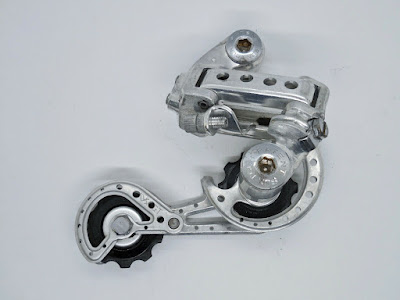No, this isn’t one of my Mercians—though you may be forgiven for thinking that it is.
Rather, it’s an almost-finished build by someone who calls himself “The Campag Kid.” Here in the US, we call Campagnolo “Campy,” but in the UK, the nickname is “Campag.”
That distinction is just one indication of how bicycle culture in England differed from that of the US or Continental Europe in the 1970s. Bicycle racing—and cycling in general—was ending a long period of dormancy. In countries like France, Belgium and Italy, the racing scene was dominated by one-day “classics” and multi-day time trials. But in England, the chief mode of competitive cycling was the time trial. So, perhaps, it’s not surprising that Campag Kid’s heroes were Alf Engers, Beryl Burton and of course Eddy Mercx.
It was Eddy who, wittingly or not, started the cult of “drillium.” The word is a portmanteau of “drilling” and “titanium,” and the practice involved, basically, drilling components—usually Campagnolo—within an inch of their lives.
The bike Eddy rode for his 1972 hour record ride was adorned with “holey” stuff. The belief then—as in some quarters today—was that “lighter is faster.” As titanium was used only for small bits like fastening nuts and carbon fiber was a couple of decades on the horizon. So aluminum and steel parts were the ones that got the treatment.
The 1970s Mercian Superlight frame Campag Kid is building lived up to its name: It was one of the lightest road frames—and had one of the tightest geometries—available at the time.
As Campag Kid explains, the cult of drillium—which was arguably even stronger in the UK than in the US—died in the 198Os as aerodynamics came to dominate high-performance bicycle component design. All of those holes came to be seen as “wind catchers,” and aerodynamic parts, although they were sometimes heavier than even non-drilled bits, were believed to be more efficient.
Whether or not drillium has any effect on speed, it certainly can be eye-catching. Oh, and I love the color of that Mercian—and the fact that it’s a Mercian!
































